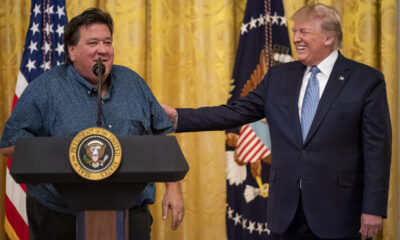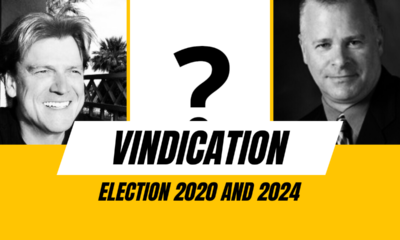Civilization
How Trump Voters Learned To Love, and Turn Out, the Mail-In Ballot
Mail-in absentee ballots, early in-person voting, and coordinating with outside groups, are how Donald Trump won the Election of 2024.

In the spring, James Blair, political director for the Trump campaign, called a meeting in West Palm Beach. The occasion: Marc Elias had changed the world.
Marc Elias got a ruling favoring outside coordination – and Team Trump decided two could play that game
It was Elias who had petitioned the Federal Election Commission at the beginning of the year to allow a George Soros-funded political action committee to coordinate with campaigns. And the Democratic super lawyer had won. A nine-page advisory opinion followed in March. For the first time, the FEC ruled that federal candidates could coordinate with outside organizations. And now politics would change forever.
Blair sensed opportunity. All he had to do, the reason he gathered the most loyal MAGA captains of the biggest grassroots armies around a conference table inside Trump campaign headquarters last April, was convince them to accept a little heresy. The political director had to teach them to love the mail-in ballot.
Trump had taught his base to hate mail balloting, a practice he blamed for his loss in 2020. Now Blair was urging the former president’s most faithful followers to embrace what was previously verboten. According to sources inside the room that day, the conversion did not go smoothly.
Charlie Kirk, founder of Turning Point USA, balked. A confidant of the Trump family, Kirk and his lieutenant Tyler Bowyer were allegedly “horrified” by the idea of pushing absentee ballots for fear of alienating MAGA diehards. Ned Ryun, CEO of American Majority Action, insisted absentee ballots were half the battle, arguing that Republican hopes would languish in long lines on Election Day without them. One source described the mood that day as “snippy.”
Skeptics come around
Turning Point spokesman Andrew Kolvet dismissed that characterization and told RealClearPolitics the organization was making plans as early as 2022 to “hammer home” the early vote.
“There were skeptics,” Blair said in retrospect. Without singling anyone out, he told RCP that “less sophisticated” operatives on the right still subscribed to “this theory that ‘well, if the votes come in early, then [Democrats] know how many they need to cheat.’” His counter-argument as he showed the grassroots the math: “No, once a vote is banked, that’s good.”
This was easier said than done, as Trump had hardwired a deep distrust into the minds of millions of Republicans by arguing that anything other than same-day voting was synonymous with fraud. “We have to get rid of mail-in ballots,” Trump said during his January victory speech after winning the Iowa caucuses. As he began his easy march through the GOP primary field, Trump added, “Once you have mail-in ballots, you have crooked elections.”
Data alone would not be enough to convince the base to abandon that belief. Only Trump could change their minds. “He had to create the permission structure for his voters,” Blair explained, “which is that voting early, whether by mail or in person, can be a pathway to victory, not to defeat.”
Clearing a primary field of Republican challengers too afraid to attack him was one thing. Unseating an incumbent president would be another. Enter Susie Wiles.
Susie Wiles looks ahead
She came from Florida, just like Blair, where Republicans had built majorities for decades despite being outnumbered by Democrats on registered voter rolls. As campaign co-chair, she had just helped Trump brush aside the primary challenge of Florida’s own governor. Then Wiles looked to the general election, directing Blair to draft a memo outlining a new Trump way to win. In short, they planned to export the Florida model.
They laid out the data, pointed to successful case studies, and ran sophisticated election simulations. But the final argument that changed Trump’s mind? “Look, sir,” the former president was told, according to sources familiar with the discussions, “people are really excited to vote for you, and they want to vote for you as soon as they have the chance to vote.” On the evening of April 19, in characteristic all caps, Trump did something very uncharacteristic: He reversed himself and blessed the mail ballot. Wrote the former president on his social media website Truth Social:
ABSENTEE VOTING, EARLY VOTING, AND ELECTION DAY VOTING ARE ALL GOOD OPTIONS. REPUBLICANS MUST MAKE A PLAN, REGISTER, AND VOTE!
Trump gives the word
Once the green light was given, the Trump machine kicked into another gear. They would still drive turnout on Election Day, but they would work just as hard to bank votes in advance. This has an obvious tactical advantage. Every supporter who cast their ballot early represented one less voter the campaign had to spend time and resources on getting to the polls on November 5. All campaigns do this. But the FEC decision that allowed federal candidates to coordinate with outside groups, the one ushered in by liberal lawyer Marc Elias, turbocharged everything. Tim Saler, chief data consultant for the Trump campaign, took full advantage.
Saler was the analytical brain behind the GOP’s ground game juggernaut. Despite all the massive reporting from the Associated Press to the New York Times suggesting the opposite, he insisted in an interview with RCP that Trump actually had one. “It was not outsourced at all,” Saler said of the get-out-the-vote apparatus. “It was coordinated.”
Flashback to Florida. Many of the groups inside Trump headquarters, almost a dozen in total, were already planning their own canvassing programs. Some had more experience than others.
Turn Out for America, a political action committee bankrolled by conservative billionaire Dick Uihlein, was on board from the beginning and widely considered among Trump operatives as “the gold standard.”
How to bank votes
American Majority Action, Ryun’s group, had just run two pilot programs the year before, one in Louisiana and another in Virginia. Ryun was convinced Republicans could win by banking votes. “We had faith in what they did,” said a source with direct knowledge of the Trump operation. The newest addition: Turning Point Action.
Kirk and Bowers leveraged their influence with millions of conservative students to create a turnout machine. “Turning Point will just need to keep evolving,” a Trump operative said of the newest edition while stressing that their efforts were welcome and helpful.
America PAC, the Elon Musk upstart that would eclipse all the rest in spending, would come later.
Saler loves them all and says each did good work. Ahead of Election Day, the first order of business was making sure the assorted groups “did no harm.” Under the new FEC paradigm, and for the first time, the campaign could communicate priorities, coordinate strategy, and share best tactics. Hence the second priority discussed at the West Palm Beach meeting: A data-sharing agreement.
Trump Force 47
“There was a real misnomer, or just a false attack, that we didn’t have a field program,” Saler said of the idea “that our field program had been farmed out.” The campaign already had in-house volunteers, a program called Trump Force 47, that fanned out to all 50 states and knocked on millions of doors on its own. What the new coordination rules provided for was the creation of the outside armies fanning out to each of the seven battleground states in search of the all-important low-propensity voter.
“The president’s coalition is more rural, lower propensity, and more down scale,” Saler explained. “Think a 35-year-old man who turns a wrench in small-town, central Wisconsin, who never engages face-to-face with anybody in politics.”
To turn out a coalition like no other, Saler had to assemble an apparatus like no other. The campaign would be at the center. They shared targeting priorities with the outside groups, who then sent their people into the field to find and identify Trump voters, building a real-time data loop. They didn’t just go where other GOP presidential campaigns had been in years past. Because of the new canvassing rules, Trump HQ could send outside groups, not just to big population centers, but door to door even in the most rural areas. On front porches, outside grocery stores, and everywhere in between, canvassers sought out the MAGA faithful, registered them to vote, and pushed them to do it early.
A unique campaign for a unique candidate
“The president is a unique character in American history; He is the champion of the forgotten man and woman,” Saler said before adding that the campaign was just as unique. “We also didn’t forget them.” In the moment, though, skepticism abounded. Some Republicans, many of them on the outside looking in, questioned the wisdom of relying so heavily on mercenary doorknockers ahead of what was sure to be a make-or-break election. Even Ben Shapiro was worried. In an October interview, Shapiro warned the former president that he was hearing mixed reviews about the ground game. Was his campaign up to the job? Trump avoided the question. In the final stretch, no one had a definitive answer.
A team of rivals, meanwhile, was working on his behalf in pursuit of low-propensity voters.
A staple on the college circuit, Kirk focused on the youth vote while directing his organization’s political arm, Turning Point Action, to decamp from campus and field an army of more than a thousand paid doorknockers across each of the swing states in pursuit of low-propensity voters overall. A spokesman denied that there was any hesitation about registering voters for absentee ballots. Instead, the organization modeled its early-vote strategy off of the Democratic playbook while making accommodations for lingering concerns over mail-in ballots.
Get the ballots in, by whatever means
The emphasis was on early voting, but if a voter preferred to cast their ballot in person on Election Day, the organization was ready to drive them to the polls. Explained Turning Point spokesman Andrew Kolvet, “We only care about getting ballots in the box.”
At times, the organization took “low propensity” to the extreme. Scott Presler, a conservative activist who partnered with Turning Point in Pennsylvania, courted a normally apolitical and untapped constituency: the Amish.
That community’s aversion to politics wasn’t the chief obstacle. It was the calendar. “Get this,” he told RCP, “Amish get married on Tuesdays in November.” Otherwise, they generally match the voter profile of a normal social conservative, he reported. Armed with that information, Presler parachuted into rural farming communities west of Philadelphia and north of Pittsburgh with absentee and mail-in ballot applications.
While Turning Point and their partners earned praise for that kind of innovation, elsewhere, some questioned the efficiency of their organization. One Turning Point intern attracted online criticism when he bragged in a social media post that he knocked on just 500 doors over the course of nine weeks, a seemingly low number.
My name is Garrett and today was my first real day off since I started working at @TPAction_ in September!
During that time I…
Registered 189 New Republican Voters
Knocked over 500 doors
Chased 281 total ballots in the box by Election Day!
I’m just an Intern so there is… pic.twitter.com/PcLJVi5Ndf— Garrett (@ggarrettpagel) November 13, 2024
Another paid Turning Point Action employee, currently under contract in Wisconsin through November, told RCP that management had set a daily goal of just 10 voter contacts.
Trump surrogates found the rare and first-time voters
“We set out on a mission to chase low-prop and first-time voters across the country,” Kirk wrote in a social media post the week after the election. Across four states (Arizona, Michigan, Nevada, and Wisconsin), according to their internal numbers, Turning Point Action had helped no less than 300,000 low-propensity voters cast their votes. “Mission accomplished,” he wrote.
🚨BALLOT CHASE UPDATE🚨
As the count stands right now (still waiting on Arizona and a few other votes), our Turning Point ballot chasers…
– Chased to completion between 205,000 and 220,000 low-propensity conservative votes in Arizona, well beyond the current margin of…— Charlie Kirk (@charliekirk11) November 9, 2024
American Majority Action took a more traditional approach with Ryun at the helm. The hard-nosed operative, who helped former Wisconsin Gov. Scott Walker become just the second state executive to survive a recall 13 years prior, had raised and deployed as many grassroots armies in the time since. The difference this time? Ever since the “Red Wave” fizzled in the 2022 midterms, Ryun had been on a one-man crusade to force Republicans to embrace absentee and early voting in earnest.
After running two successful pilot programs in state races, he was convinced the GOP could take the approach national. Trump supporters would learn to love the mail-in ballot, he was convinced, once they won with it. Toward that end, American Majority picked four targets: Arizona, Nevada, North Carolina, and Wisconsin. They hired 1,600 staff, drilling into each canvasser two numbers: Seven and nine. Between seven and nine is how many times a single low-propensity voter, on average, must be contacted before they will return a mail-in ballot. A blunt Ryun calls it “targeted harassment.”
Millions of phone calls, texts, and door knocks
According to an after-action report, the group made more than 11 million phone calls in support of Trump and sent just shy of four million texts to voters in each of their four target states. They knocked on nearly 2 million doors.
On the eve of the election, Ryun wrote in an op-ed for “American Greatness” that Republicans had experienced their fair share of growing pains. It would take time for the GOP to catch up to Democrats on the early voting front, but overall, the conservative movement earned a passing grade: “A solid B to B+ level with lots of room for growth.”
America PAC was the last big group to arrive. Elon Musk endorsed Trump after the first assassination attempt, and while Republicans welcomed the many millions of dollars from the world’s richest man, the political novice attracted his fair share of scrutiny. His group planned to compete in all seven battleground states. They initially hired just a handful of vendors to execute a one-size-fits-all, top-down strategy.
Elon Musk weighs in
By the end of the summer, though, Musk fired his initial team and hired Genera Peck and Phil Cox, veterans of the defunct DeSantis campaign, to put together a national plan with individual directors in each of the battleground states. They took a tailored approach, and by the end, Musk lent his celebrity to the Pennsylvania campaign, a state he often told voters was the key to the whole election. His group spent north of $200 million, a deep war chest that lent itself to sending canvassers nearly everywhere.
The scope of all of this was relatively new territory. Few national, grassroots organizations previously had the resources and expertise to chase votes across multiple states concurrently. Each additional battleground added another level of complexity and difficulty. But it wasn’t all top-down. A patchwork of groups supplemented the work in the individual swing states.
Motivated by the frustration that the right had “yielded voter registration to the left,” former Georgia Sen. Kelly Loeffler launched “Greater Georgia” in the Peach State. The group identified tens of thousands of conservative Georgians and helped get them registered to vote. Another state-specific get-out-the-vote engine to the north: PA Chase. Founded by Cliff Maloney, that organization canvassed throughout Pennsylvania in search of low-propensity voters in need of a mail-in ballot. “We’re finally catching up to the Democrats,” Maloney said of his efforts before Election Day. “This is straight out of their playbook, right?
How Trump took the popular vote
In this way, the Trump campaign and its allies chased the low-propensity voter. And it worked. He not only swept each swing state on his way to becoming just the second president in history to win non-consecutive terms, but Trump also won the popular vote, something Republicans haven’t achieved since 2004. Said Saler of the electorate that returned the former and future president to the Oval Office, “He created them.” Many were first-time voters. Some voted only for him. Now every Republican operative involved in planning for the midterms and the next general election is focused on one question: How to keep these voters in the GOP fold? It will likely include a heavy emphasis on the early vote.
Trump World, even in victory, sees the mail-in ballot as a pragmatic necessity, not an ideal way to vote. “Look, they’re not perfect, and if we could just do away with them, we probably would, but that’s not the world we live in,” Blair said. “They exist. So, it is what it is.”
For his part, Ryun has become their biggest apostle of early voting and the mail-in ballot. After Republicans won big, he isn’t in a hurry to see the GOP set them aside. “I’m telling you, this works, and this should be our game planning forward,” he said, before adding that a more pressing question for the right was discerning which groups did real work and which did little more than gobble up donor dollars.
On to Midterms
“There are some vaporware organizations, like Turning Point, that I’m afraid were not as effective as they could have been because they were on a journey of self-discovery in politics,” Ryun said. “My concern for the future is, how do we make sure that some of these voters who turned out for Trump-only become consistent Republican voters.”
A Turning Point spokesman dismissed that criticism. Said Kolvet, “We’re not in the business of getting down in the mud.” The results, he said, speak for themselves. “The campaign, which knows the data and accomplishments well, knows how successful our program was,” the spokesman concluded.
Republicans will have their work cut out for them in the midterms. They have historically underperformed whenever Trump is not on the ballot. The coordination between federal candidates and outside groups – that the FEC allowed at the insistence of Democrats like Elias – will not change. It was central to a Trump victory.
“Thank you, Marc,” quipped Saler, the Trump data consultant who helped engineer the former, and future, president’s comeback. “We appreciate you.”
This article was originally published by RealClearPolitics and made available via RealClearWire.
Philip Wegmann is White House Correspondent for Real Clear Politics. He previously wrote for The Washington Examiner and has done investigative reporting on congressional corruption and institutional malfeasance.
-

 Civilization3 days ago
Civilization3 days agoDC Pipe Bomb Arrest Raises Questions About Christopher’s Wray’s FBI
-

 Civilization4 days ago
Civilization4 days agoThe Legal Logic Behind U.S. Operations Against Narco-Terrorist Networks
-

 Executive4 days ago
Executive4 days agoNewsom’s ‘National Model’ for Homeless Wracked by Fraud
-

 Executive3 days ago
Executive3 days agoWhen You’re in a Hole, Stop Digging
-

 Education3 days ago
Education3 days agoWaste of the Day: Taxpayers Subsidize Football Coach Severance
-

 Executive2 days ago
Executive2 days agoWaste of the Day: Obamacare Failed Test, Approved Fraudulent Subsidies
-

 Civilization2 days ago
Civilization2 days agoPence Calls on Trump To Fire RFK Jr Over Abortion Drug
-

 Executive4 days ago
Executive4 days agoWaste of the Day: Feds Pay Nonprofits That Sue the Government












